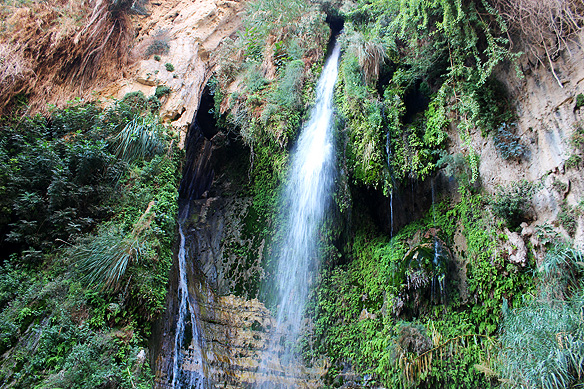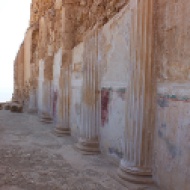
It was 2 am and I could not take my eyes off the exhilarating landscape in the travel documentary. I sat hunched over my computer with goose bumps on my arms, infatuated at the desert and oasis and sea which unfurled in front of me. I was leaving for Israel in a couple of weeks.
“This can’t be for real???” was all my cynical mind could muster at regular intervals. But numerous other media reiterated the same splendours with stubborn vendetta to my doubting self.
Not many places live up to their hype—except the Judaean Desert. As I discovered last year in November.
Not to be confused as part of the desolate Negev Desert, the Judaean Desert is an arid strip stretching from the east of Jerusalem to the Dead Sea, across Israel and the West Bank. The 25-kilometre-wide rain-shadow desert is criss-crossed with deep crumbling limestone ravines which change colour as the sun makes its way across the spotless blue sky. On the western side it rises to 800 metres. On its eastern edge it plunges to -430 metres, the lowest point on earth.
Through the ages, many who had to leave or flee Jerusalem, often took refuge in its folds. Whether it was the legendary King David, Biblical John the Baptist, or historical Herod the Great. Or whether it was zealous Jewish religious sects such as the Essenes or Sicarii seeking refuge from the Romans. Or puritanical Catholic monks fleeing the mainstreaming of their faith by the Byzantines.
On the “other” side of the hills encircling Jerusalem, the Judaean Desert promised them all a haven. Is it any wonder then that the desert has earned itself the moniker “Desert of the Holy City”?
The eclectic combination of ethereal geographic beauty and a dramatic rich history has created three jewels in the Judaean Desert’s midst over the millennia: Masada, Ein Gedi and the Dead Sea, each more fantastical than the other.
These three places are beyond hype and crowds; they give us goose bumps both before and after we visit them. Let me take you on my excursion to the Judaean Desert, and perhaps you will also agree, sites like these are why we travel in the first place.
– – –
Masada, the Fortress in the Sky

Perched on a 1,300-feet-high chalk and dolomite mesa in the deserted Judaean Desert, the Masada National Park is not just a place. It is an emotion, an ideology. A place steeped in the grandeur of nature and human endeavour.
It is the story of a persecution-complex persecutor, Herod, the Roman appointed King of Judaea, who built a fortress on it in 27 BC to house his private leisure palace and haven from his enemies.
The finest European wines and sauces garnished his sumptuous meals here. His home cascaded down the northern edge of the cliff in a flurry of exquisite Roman columns, frescoes, and mosaics. Twelve gigantic water cisterns cut into the mountainside and 29 granaries ensured an endless supply of water and food. Elaborate Roman baths and swimming pools maintained Roman ideas of civilized life.
Masada, meaning “stronghold” is also the story of the last Jewish community in Judaea. It is the story of 960 members of the zealous Jewish sect, Sicarii, led by Eleazer Ben Yair who took refuge in its ruins in 66 AD, seven decades after Herod’s death while Jerusalem was being burnt to the ground by the Romans.
After a 4-month long siege, the 8,000 strong Roman army finally broke into the Sicarii stronghold atop Masada on 15 April 73 AD, only to find piles of corpses insides its walls. All, except two women and five children, chose to kill themselves rather than be taken into slavery.
Five hundred and fifty metres long, and 270 metres wide, the flat top of the mesa is edged by a 4-metre-high casement wall and strewn with ruins where each stone has a tale to tell.
Whether it be for the thrill of its physical scale, the audacity of its architecture or the tragic end of its witnessed heroism, Masada will always be etched in history and in the memories of those who choose to experience it.
[Note: Click on any of the below images and it will start a slide show with captions.]
Ein Gedi, Israel’s Garden of Eden

When Israelis want to get away from it all, Ein Gedi is where they head off to. A habit very much in keeping with countless others who have also found their way to it for the past five thousand years. Even King David had scaled its paths when he escaped the vengeful and jealous King Saul in the Old Testament.
With good reason.
In an otherwise hot and arid country, Ein Gedi, Israel’s largest, and perhaps most scenic oasis and a nature reserve since 1971, comes as a breath of fresh air with its sparkling waterfalls, limpid pools, and colossal limestone cliffs. The crystal-clear springs which leap out from verdant curtains of foliage, deep in its recesses, have been a source of sustenance since antiquity as augmented by its chalcolithic ruins and remains of a 1,700-year-old Jewish settlement.
The walk through the nature reserve is, however, no walk in the park! But then, as I discovered during my stay in Israel, Israelis are easily one of the healthiest bunch under the sun. But that observation is for another post.
Coming back to Ein Gedi, meaning Spring of the Kid-Goat, if it weren’t for the guide and co-travellers in the tour who were quick to give a helping hand, I may well have limited my exploration to ground level and not ventured into the upper section of Wadi David.
Armed with their sturdy support, I clambered through rivulets flowing under tunnels of reed, mounted buttery boulders, emerged at Ein Gedi’s pièce de résistance, the David Waterfall, only to lunge myself up higher on the cliffs lined with Byzantine monks’ caves for outrageously spectacular views of the Judaean Desert and the Dead Sea.
Through this all, for company I had Nubian ibexes grazing on acacia trees, unfazed by my proximity, while rock hyraxes stared from behind rocks, petulant at my wandering into their territory. Both justified, I would say.
[Note: Click on any of the below images and it will start a slide show with captions.]
Dead Sea, which is neither Dead nor a Sea

Think of Israel, and the first highlight to spring to mind for most secular and atheist travellers would be the hyper-saline Dead Sea at 430 metres below sea level. Floating in its potassium, bromine, and magnesium rich waters whilst caked in its equally rich clay are research-backed guarantees to a more beautiful you.
But if the idea of getting all muddy and wet is not exactly your idea of the good life [it wasn’t mine], there is plenty else to do. Like having a picnic lunch on its salt-crusted shores [makes it easier for seasoning those boiled eggs] and going for an aimless amble along the coast as the golden sun gets ready to wrap up a perfect day.
One of Israel’s most famous attractions, the iconic Dead Sea is shared with Jordan on its eastern shore and is in fact, despite its name, not a sea at all, but a lake, and not exactly dead either. It is the remnants of a huge pre-historic lake called Lake Lissan that has shrunk 200 metres in depth over the past 12,000 years to its present form at the lowest point on earth. And its waters teem with bacteria and microbial fungi.
The sad part is the shrinking is still ongoing as a result of a dam built over its original source of water the Jordan River, global warming, and evaporation pools for mineral harvesting on its southern shores.
Every year the Dead Sea is losing one metre in depth. The sinkholes, some 10 metres in diameter on its beaches are a gentle reminder for us to be gentler with nature. We only have one earth, and one Dead Sea in it.
And with that sobering thought, ends one of my most spectacular days in Israel. ❤
[Note: Click on any of the below images and it will start a slide show with captions.]
Travel tips:
- Egged bus #486 runs this route but the most convenient way to cover all three in a day is with a tour.
- I took the one run by Abraham Tours from Jerusalem and loved it. Why?
- Because it is self-guided, and the day I took it there was also a super-helpful and well-versed guide on the tour for those who wished to use his services.
- It gives you ample time at each stop so you don’t miss anything.
- To know more about the Abraham tour I took, click here.
- To know more about the three sites, their official website links are: Masada, Ein Gedi and the Dead Sea.
– – –
[Note: This blog post is part of a series from my solo and independent travel to Israel for 15 days in November 2019. To read more posts in my Israel series, click here.]




























The Masada is indeed out-of-this-world. I can imagine how opulent the fortress was during its heyday. The surrounding area also looks like Mars 🙂
LikeLiked by 1 person
Haha, yes, it does look like Mars. 😀 I think, of all the sites and cities I visited in Israel this one day will remain etched in my mind and heart forever. It was all so beautiful!
LikeLiked by 1 person
Hey Rama, I love all of your posts. The way you carry your passion towards exploring this world is beyond words. It’s an honour for me to nominate you for the Blogger Recognition Award. I hope you will accept.
Regards
Tanya.😊
LikeLiked by 1 person
Thank you, Tanya. I am truly flattered. Your unflinching encouragement means a lot to me. I will unfortunately have to decline. I am not into awards. I blog because I enjoy it. The fact that I have readers who enjoy my posts is a blessing for me. And for me that is enough. I hope you understand. God bless.
LikeLike
Sadly I don’t know about that. Yup I understood. Rock as always Rama. I am a great fan of your blog. Keep going.🤗My love to you❤
LikeLiked by 1 person
Loved your post and wish I had enough time to do this when I visited Israel along with Egypt.
LikeLiked by 1 person
A reason for you to go back! There is just so much to Israel. I spent 15 days and am already thinking I need another 15 days for my second visit. 😀
LikeLike
Beautiful pictures
LikeLiked by 1 person
Thank you, Urvashi! Welcome to my blog. Israel is a very beautiful country. I hope you enjoy reading the rest of the posts in my Israel series too. 🙂
LikeLike
Yes I like pictures too
LikeLike
Yes l like pictures is a beautuful
LikeLiked by 1 person
Thanks much. 🙂
LikeLike
♥♥♥♥
LikeLike
Pingback: the short and smart guide to independent travel in israel | rama arya's blog